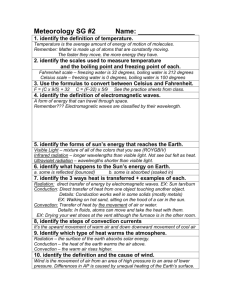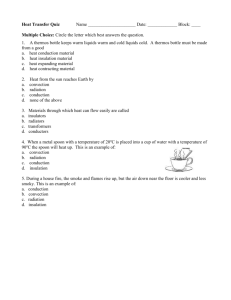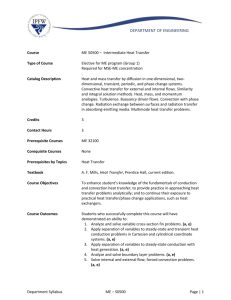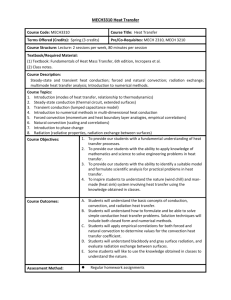Chapter 11
advertisement
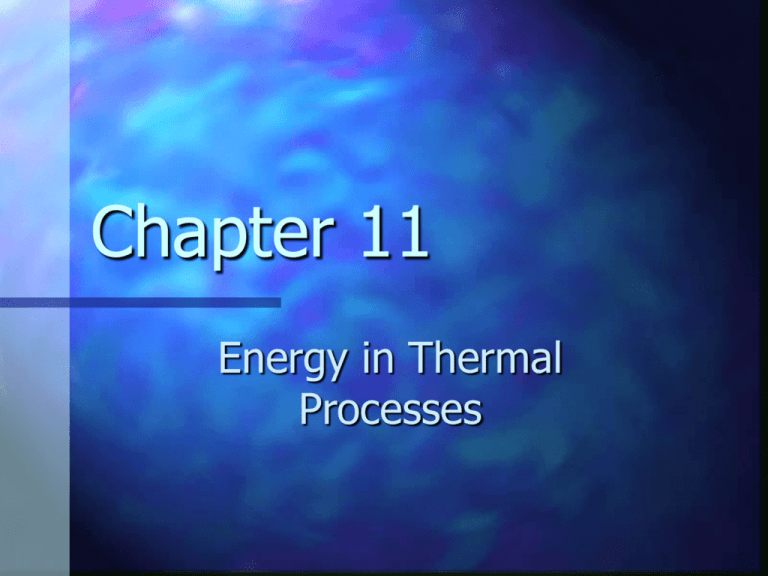
Chapter 11 Energy in Thermal Processes Heat Compared to Internal Energy Important to distinguish between them They mean very different things when used in physics Internal Energy Internal Energy, U, is the energy associated with the microscopic components of the system Includes kinetic and potential energy associated with the random translational, rotational and vibrational motion of the atoms or molecules Also includes the intermolecular potential energy Heat Heat is a mechanism by which energy is transferred between a system and its environment because of a temperature difference between them The system Q is used to represent the amount of energy transferred by heat between a system and its environment Units of Heat Calorie An historical unit, before the connection between thermodynamics and mechanics was recognized A calorie is the amount of energy necessary to raise the temperature of 1 g of water from 14.5° C to 15.5° C . A Calorie (food calorie) is 1000 cal 1 cal = 4.186 J This is called the Mechanical Equivalent of Heat Units of Heat, cont. US Customary Unit – BTU BTU stands for British Thermal Unit A BTU is the amount of energy necessary to raise the temperature of 1 lb of water from 63° F to 64° F Specific Heat Every substance requires a unique amount of energy per unit mass to change the temperature of that substance by 1° C The specific heat, c, of a substance is a measure of this amount Q c m T Units of Specific Heat SI units J / kg °C Historical units cal / g °C Heat and Specific Heat Q = m c ΔT ΔT is always the final temperature minus the initial temperature When the temperature increases, ΔT and ΔQ are considered to be positive and energy flows into the system When the temperature decreases, ΔT and ΔQ are considered to be negative and energy flows out of the system Consequences of Different Specific Heats Water has a high specific heat compared to land On a hot day, the air above the land warms faster The warmer air flows upward and cooler air moves toward the beach Calorimeter One technique for determining the specific heat of a substance A calorimeter is a vessel that is a good insulator that allows a thermal equilibrium to be achieved between substances without any energy loss to the environment Calorimetry Analysis performed using a calorimeter Conservation of energy applies to the isolated system The energy that leaves the warmer substance equals the energy that enters the water Qcold = -Qhot Negative sign keeps consistency in the sign convention of ΔT Phase Changes A phase change occurs when the physical characteristics of the substance change from one form to another Common phases changes are Solid to liquid – melting Liquid to gas – boiling Phases changes involve a change in the internal energy, but no change in temperature Latent Heat During a phase change, the amount of heat is given as L is the latent heat of the substance Q=mL Latent means hidden or concealed Choose a positive sign if you are adding energy to the system and a negative sign if energy is being removed from the system Latent Heat, cont. Latent heat of fusion is used for melting or freezing Latent heat of vaporization is used for boiling or condensing Table 11.2 gives the latent heats for various substances Graph of Ice to Steam Warming Ice Start with one gram of ice at –30.0º C During A, the temperature of the ice changes from – 30.0º C to 0º C Use Q = m c ΔT Melting Ice Once at 0º C, the phase change (melting) starts The temperature stays the same although energy is still being added Use Q = m Lf Warming Water Between 0º C and 100º C, the material is liquid and no phase changes take place Energy added increases the temperature Use Q = m c ΔT Boiling Water At 100º C, a phase change occurs (boiling) Temperature does not change Use Q = m Lv Heating Steam After all the water is converted to steam, the steam will heat up No phase change occurs The added energy goes to increasing the temperature Use Q = m c ΔT Problem Solving Strategies Use consistent units Transfers in energy are given as Q=mcΔT for processes with no phase changes Use Q = m Lf or Q = m Lv if there is a phase change In Qcold = - Qhot be careful of sign ΔT is Tf - Ti Methods of Heat Transfer Need to know the rate at which energy is transferred Need to know the mechanisms responsible for the transfer Methods include Conduction Convection Radiation Conduction The transfer can be viewed on an atomic scale It is an exchange of energy between microscopic particles by collisions Less energetic particles gain energy during collisions with more energetic particles Rate of conduction depends upon the characteristics of the substance Conduction example The molecules vibrate about their equilibrium positions Particles near the flame vibrate with larger amplitudes These collide with adjacent molecules and transfer some energy Eventually, the energy travels entirely through the rod Conduction, cont. In general, metals are good conductors They contain large numbers of electrons that are relatively free to move through the metal They can transport energy from one region to another Conduction can occur only if there is a difference in temperature between two parts of the conducting medium Conduction, equation The slab allows energy to transfer from the region of higher temperature to the region of lower temperature Th Tc Q P kA t L Conduction, equation explanation A is the cross-sectional area L = Δx is the thickness of the slab or the length of a rod P is in Watts when Q is in Joules and t is in seconds k is the thermal conductivity of the material See table 11.3 Good conductors have high k values and good insulators have low k values Home Insulation Substances are rated by their R values R=L/k More multiple layers, the total R value is the sum of the R values of each layer Wind increases the energy loss by conduction in a home Convection Energy transferred by the movement of a substance When the movement results from differences in density, it is called natural conduction When the movement is forced by a fan or a pump, it is called forced convection Convection example Air directly above the flame is warmed and expands The density of the air decreases, and it rises The mass of air warms the hand as it moves by Convection applications Radiators Upwelling Cooling automobile engines Algal blooms in ponds and lakes Radiation Radiation does not require physical contact All objects radiate energy continuously in the form of electromagnetic waves due to thermal vibrations of the molecules Rate of radiation is given by Stefan’s Law Radiation example The electromagnetic waves carry the energy from the fire to the hands No physical contact is necessary Radiation equation P = σAeT4 P is the rate of energy transfer, in Watts σ = 5.6696 x 10-8 W/m2 K4 A is the surface area of the object e is a constant called the emissivity e varies from 0 to 1 T is the temperature in Kelvins Energy Absorption and Emission by Radiation With its surroundings, the rate at which the object at temperature T with surroundings at To radiates is Pnet = σAe(T4 – T4o) When an object is in equilibrium with its surroundings, it radiates and absorbs at the same rate Its temperature will not change Ideal Absorbers An ideal absorber is defined as an object that absorbs all of the energy incident on it e=1 This type of object is called a black An ideal absorber is also an ideal radiator of energy body Ideal Reflector An ideal reflector absorbs none of the energy incident on it e=0 Applications of Radiation Clothing Thermography Black fabric acts as a good absorber White fabric is a better reflector The amount of energy radiated by an object can be measured with a thermograph Body temperature Radiation thermometer measures the intensity of the infrared radiation from the eardrum Resisting Energy Transfer Dewar flask/thermos bottle Designed to minimize energy transfer to surroundings Space between walls is evacuated to minimize conduction and convection Silvered surface minimizes radiation Neck size is reduced Global Warming Greenhouse example Visible light is absorbed and re-emitted as infrared radiation Convection currents are inhibited by the glass Earth’s atmosphere is also a good transmitter of visible light and a good absorber of infrared radiation
![Applied Heat Transfer [Opens in New Window]](http://s3.studylib.net/store/data/008526779_1-b12564ed87263f3384d65f395321d919-300x300.png)
